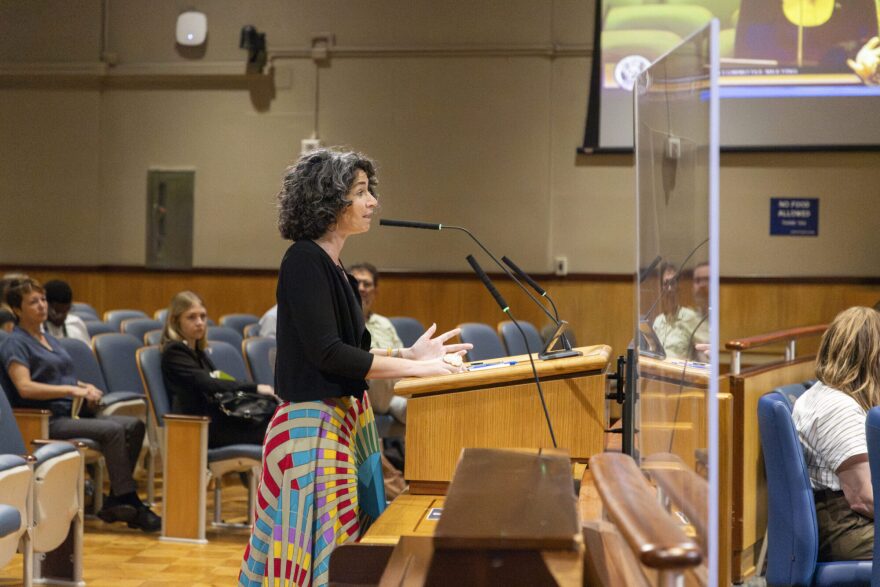Sign up for Verite's free, bi-weekly newsletter and get the New Orleans news you need on Tuesday mornings and Thursday afternoons.Local bicycle safety advocacy group Bike Easy called for protected bike lanes on St. Claude Avenue and increased infrastructure for cyclists across the city during a presentation at a City Council transportation committee meeting on Tuesday (July 22).
While the Safer St. Claude campaign has been in the works since 2023, Bike Easy has felt a renewed sense of urgency in the wake of yet another cyclist death in the area, according to Laura Harris, the group’s education and policy manager.
The meeting closely followed the death of Michael Milam, 36, who was struck and killed on July 12 while biking on St. Claude Avenue and Alvar Street.
“It’s kind of crazy because we were already on the schedule to talk about this campaign and then another person was killed,” Harris said. “It feels like the fire is on.”
Bike Easy’s Executive Director Allene La Spina highlighted three other New Orleanians who have died, including Dustin Strom, who was killed in June 2023 at the intersection of St. Claude Avenue and Marigny Street. According to the presentation, nine cyclists were killed in crashes from 2017 to 2021.
As La Spina read aloud a statement from Strom’s parents, meeting attendees held up signs with photos of him and other cyclists who have died in traffic incidents.
“Dustin will never have the privilege to be a husband or a father or continue his love of meeting wonderful people, or seeing all the beauty of his world,” the statement from Strom’s parents read. “I urge you to please make the streets safer for a bicyclist so no one else has to lose a loved one.”
Bike Easy called for a protected bike lane, which creates a physical barrier between cyclists and cars by using flexible plastic sticks or a raised curb. These protections would affect hundreds of bikers a day — according to the presentation, St. Claude Avenue sees 341 cyclists daily. Overall, New Orleans has the fifth-highest rate of bike commuters per capita nationwide, but is also ranked among the most deadly for cyclists.
Harris pointed to previous successes with bike lanes in the city, namely a stretch of Elysian Fields Avenue near St. Claude Avenue which has not seen a fatality since the city installed protected bikeways in 2020. Before, there were 20 crashes and one death on the street from 2014 to 2018.
The presentation also highlighted other safety issues, including cracked sidewalks and a lack of enforcement when cars illegally park in bike lanes.
Councilmember Eugene Green noted that the city does not have complete control when it comes to St. Claude — because it is a state highway, the Louisiana Department of Transportation and Development is responsible for implementing any changes to the street.
“I don’t have the ability on my own to create a bike lane on St. Claude,” Green said.
More than a dozen people provided public comments in support of the Safer St. Claude campaign, sharing stories about the trauma of watching people die in bike accidents and encouraging the city to take action.

Nellie Catzen, executive director for non-profit Committee for a Better New Orleans, emphasized the importance of using physical infrastructure to improve safety.
“We fundamentally are not going to be able to change the attitudes and actions of every person,” Catzen said. “What we can do is build streets that are safer, so when people make bad choices, everybody else around them can continue to be safe.”
Victor Pizarro, who has worked with the New Orleans Community Bike Project to distribute over 8,000 free bikes, also urged the city to get more involved.
“One of the most important things we can do to honor and respect these deaths is to come together as a city and demand accountability from the state,” Pizarro said. “I think we should expect y’all to stand up to the state and be with us completely.”
Matt Rufo, transportation policy and program manager for the city’s Office of Resilience and Sustainability, said that the Louisiana DOTD has attended advisory committee meetings for the Safe Streets for All initiative, which aims to reduce fatal crashes.
Still, he says, the city needs to schedule a meeting with the state where they can determine what changes the state can commit to.
“We can’t do it alone,” Rufo said. “We welcome the council’s participation in encouraging the state to come to the table. So far [the state has] been involved in conversations and we look forward to them being more involved.”
Green, the Transportation and Development Committee’s chair, was the only council member present at Tuesday’s meeting, as multiple speakers noted during public comment.
Bike Easy closed its presentation with a request for the city to gather more data on bike trends on St. Claude Avenue and collaborate with the state to prevent further deaths.
“We need all the agencies to work together,” La Spina said. “It is a New Orleanian who is dying on this street, not a person who is aware that he is biking onto a state road and is in more danger there.”


